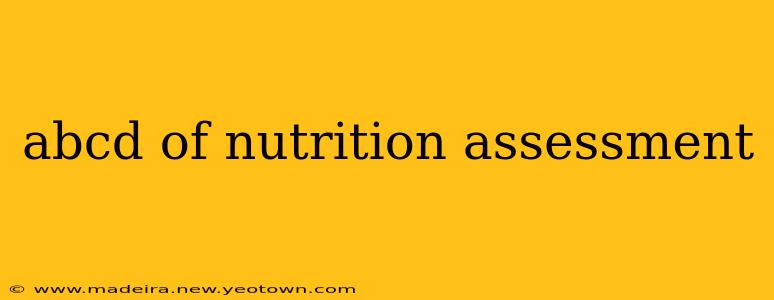Unlocking the secrets to good health often begins with understanding your body's nutritional needs. This isn't just about counting calories; it's a journey of discovery, a process of understanding how the food you eat fuels your life. This guide breaks down the ABCD's of nutrition assessment, providing a framework for understanding your nutritional status and paving the way towards a healthier you.
A is for Anthropometry: Measuring Your Body's Physical Composition
Imagine a detective investigating a crime scene; they meticulously gather clues to piece together the story. Similarly, a nutrition assessment starts with anthropometry – the science of measuring the human body. This isn't about vanity; it's about gathering crucial data. Anthropometric measurements offer insights into your body composition, including:
- Height and Weight: These basic measurements provide your Body Mass Index (BMI), a helpful indicator of weight status, though it doesn't tell the whole story.
- Waist Circumference: This measurement helps assess abdominal fat, a significant risk factor for various health problems.
- Body Composition Analysis: More sophisticated methods, like DEXA scans or bioelectrical impedance analysis, can measure your percentage of body fat, muscle mass, and bone density.
These measurements give a snapshot of your current physical state, providing a baseline for further investigation. They aren't definitive on their own, but when combined with other assessment methods, they paint a clearer picture of your nutritional health.
B is for Biochemical Assessment: Examining Your Body's Internal Landscape
While anthropometry provides external clues, biochemical assessment delves into your body's internal workings. This involves analyzing blood, urine, and other bodily fluids to measure levels of various nutrients and metabolic byproducts. Key aspects of this assessment include:
- Blood Tests: These reveal your blood glucose levels, cholesterol profile, iron stores, vitamin levels, and more. These tests offer a window into your metabolic processes and nutrient deficiencies.
- Urine Analysis: Urine tests can detect deficiencies or excesses of certain vitamins and minerals. They can also indicate kidney function, which plays a vital role in nutrient processing.
This stage reveals subtle imbalances that may not be evident through anthropometry alone. For example, you might appear healthy based on your weight, but biochemical tests might reveal an iron deficiency or a problem with your lipid profile.
What are some common biochemical indicators used in a nutrition assessment?
Biochemical indicators commonly used in a nutrition assessment include blood glucose levels, lipid profiles (cholesterol and triglycerides), hemoglobin levels (for iron status), albumin levels (for protein status), and vitamin and mineral levels (e.g., vitamin D, vitamin B12, folate). The specific tests used will depend on the individual's health concerns and the goals of the assessment.
C is for Clinical Assessment: Observing the Signs and Symptoms
This part of the assessment focuses on the observable signs and symptoms related to nutritional deficiencies or excesses. This involves a thorough physical examination by a healthcare professional, looking for visible indicators like:
- Skin Conditions: Dry skin, hair loss, or easily bruised skin can suggest deficiencies in essential fatty acids, vitamins, or minerals.
- Muscle Weakness: This might indicate protein deficiency or problems with electrolyte balance.
- Fatigue and Lethargy: Persistent fatigue can be a sign of various nutritional deficiencies.
- Neurological Symptoms: Numbness, tingling, or impaired cognitive function might point to deficiencies in B vitamins or other essential nutrients.
The clinical assessment combines the information gathered from anthropometry and biochemical assessments to create a more complete picture. For example, if your weight is low and you also exhibit fatigue and brittle hair, a clinical assessment would help identify potential deficiencies requiring intervention.
How is a clinical assessment different from a biochemical assessment?
A clinical assessment is a visual and observational assessment, focusing on the signs and symptoms visible to a healthcare professional. A biochemical assessment, on the other hand, involves laboratory testing of bodily fluids to measure nutrient levels and metabolic markers. Both methods are complementary and provide different perspectives on the nutritional status.
D is for Dietary Assessment: Understanding Your Eating Habits
The final piece of the puzzle is the dietary assessment. This involves exploring your typical eating habits and patterns, uncovering your strengths and weaknesses in dietary intake. This process can involve:
- Food Frequency Questionnaires: These questionnaires assess how often you consume specific foods.
- 24-Hour Dietary Recall: This involves recalling everything you ate and drank in the past 24 hours.
- Food Records: This method involves keeping a detailed record of everything you eat and drink over a specified period (e.g., 3-7 days).
Dietary assessment provides invaluable insight into your micronutrient and macronutrient intake, allowing for identification of areas for improvement. By analyzing your dietary intake, you can pinpoint potential deficiencies or excesses and make targeted changes.
What is the most accurate method of dietary assessment?
There is no single “most accurate” method of dietary assessment. Each method has strengths and weaknesses. Food records, while time-consuming, offer more comprehensive data over a longer period. 24-hour recalls are quicker but rely on memory. Food frequency questionnaires are convenient but lack detailed information on portion sizes. The best method depends on the specific needs and resources available.
By combining these four elements—Anthropometry, Biochemical Assessment, Clinical Assessment, and Dietary Assessment—you gain a holistic understanding of your nutritional status. It's a collaborative process often involving registered dietitians, doctors, and other healthcare professionals working together to create personalized nutrition plans that support your overall health and well-being. Remember, this is not a one-time snapshot; regular assessments are crucial for tracking progress and adapting your approach to maintain optimal nutrition throughout your life.

